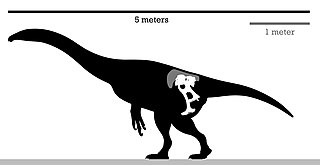
Enigmosaurus is a genus of therizinosauroid that lived in Asia during the Late Cretaceous period. It was a medium-sized, ground-dwelling, bipedal herbivore that represents the third therizinosaur taxon from the Bayan Shireh Formation, although it is known from the lower part. The genus is monotypic, including only the type species E. mongoliensis, known from a well preserved pelvis and other tentative body remains.

Garudimimus is a genus of ornithomimosaur that lived in Asia during the Late Cretaceous. The genus is known from a single specimen found in 1981 by a Soviet-Mongolian paleontological expedition in the Bayan Shireh Formation and formally described in the same year by Rinchen Barsbold; the only species is Garudimimus brevipes. Several interpretations about the anatomical traits of Garudimimus were made in posterior examinations of the specimen, but most of them were criticized during its comprehensive redescription in 2005. Extensive undescribed ornithomimosaur remains at the type locality of Garudimimus may represent additional specimens of the genus.

Alectrosaurus is a genus of tyrannosauroid theropod dinosaur that lived in Asia during the Late Cretaceous period, about some 96 million years ago in what is now the Iren Dabasu Formation.

Achillobator is a genus of large dromaeosaurid theropod dinosaur that lived during the Late Cretaceous period about 96 million to 89 million years ago in what is now the Bayan Shireh Formation of Mongolia. The genus is currently monotypic, only including the type species A. giganticus. The first remains were found in 1989 during a Mongolian-Russian field expedition and later described in 1999. Remains at the type locality of Achillobator may represent additional specimens. It represents the first and largest dromaeosaurid known from the Bayan Shireh Formation.

Archaeornithomimus is a genus of ornithomimosaurian theropod dinosaur that lived in Asia during the Late Cretaceous period, around 96 million years ago in the Iren Dabasu Formation.

Bagaceratops is a genus of small protoceratopsid dinosaurs that lived in Asia during the Late Cretaceous, around 72 to 71 million years ago. Bagaceratops remains have been reported from the Barun Goyot Formation and Bayan Mandahu Formation. One specimen may argue the possible presence of Bagaceratops in the Djadochta Formation.

The Bayan Shireh Formation is a geological formation in Mongolia, that dates to the Cretaceous period. It was first described and established by Vasiliev et al. 1959.

Tsagantegia is a genus of medium-sized ankylosaurid thyreophoran dinosaur that lived in Asia during the Late Cretaceous period. The genus is monotypic, including only the type species, T. longicranialis. The specimen consists of a very partial individual, comprising the skull and lacking postcranial remains. Since it only preserves the skull, Tsagantegia is mainly characterized by its elongated snout and the flattened facial osteoderms, greatly differing from other ankylosaurs.

Gilmoreosaurus is the name given to a genus of dinosaur from the Cretaceous of Asia. The type species is Gilmoreosaurus mongoliensis. It is believed to be a hadrosaur or iguanodont from the Iren Dabasu Formation of Inner Mongolia, dating to 96 Ma ago. Additional specimens have been described as distinct species, including G. atavus from the Khodzhakul Formation of Uzbekistan and G. arkhangelskyi from the Bissekty Formation. However, these are based on very fragmentary remains, and their classification is dubious. An additional species, G. kysylkumense is sometimes included, though it has also been referred to the related genus Bactrosaurus.
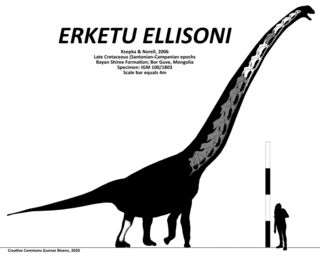
Erketu is a genus of somphospondylan sauropod dinosaur that lived in Asia during the Late Cretaceous roughly between 96 million and 89 million years ago. Its fossils were found in Mongolia between 2002 and 2003 during a field expedition and first described in 2006; later on in 2010 due to some cervicals that were left behind in the expedition. Erketu represents one of the first sauropods described from the Bayan Shireh Formation. The elongated cervical vertebrae of Erketu indicates that it was the sauropod with the longest neck relative to its body size.
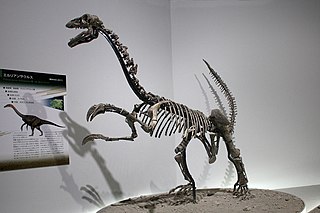
Erliansaurus is a genus of therizinosaur theropod dinosaur that lived in Asia during the Cenomanian stage of the Late Cretaceous period in what is now Nei Mongol, Iren Dabasu Formation.
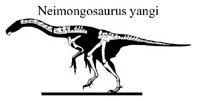
Neimongosaurus is a genus of herbivorous therizinosaur theropod dinosaur that lived in Asia during the Cenomanian stage of the Late Cretaceous period in what is now the Iren Dabasu Formation.

Sonidosaurus is a genus of sauropod dinosaur from the Late Cretaceous. It was a titanosaur which lived in what is now Inner Mongolia. The type species, Sonidosaurus saihangaobiensis, was described by Xu, Zhang, Tan, Zhao, and Tan in 2006. It was a small titanosaur, about 9 meters (30 ft) long. It was first discovered in the Iren Dabasu Formation in 2001 in a quarry which would later yield the remains of Gigantoraptor starting in 2005.
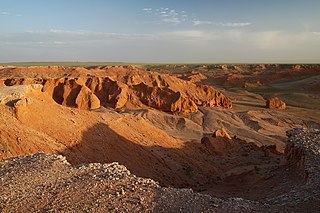
The Djadochta Formation is a highly fossiliferous geological formation situated in Central Asia, Gobi Desert, dating from the Late Cretaceous period, about 75 million to 71 million years ago. The type locality is the Bayn Dzak locality, famously known as the Flaming Cliffs. Reptile and mammal remains are among the fossils recovered from the formation.

Caenagnathidae is a family of derived caenagnathoid dinosaurs from the Cretaceous of North America and Asia. They are a member of the Oviraptorosauria, and relatives of the Oviraptoridae. Like other oviraptorosaurs, caenagnathids had specialized beaks, long necks, and short tails, and would have been covered in feathers. The relationships of caenagnathids were long a puzzle. The family was originally named by Raymond Martin Sternberg in 1940 as a family of flightless birds. The discovery of skeletons of the related oviraptorids revealed that they were in fact non-avian theropods, and the discovery of more complete caenagnathid remains revealed that Chirostenotes pergracilis, originally named on the basis of a pair of hands, and Citipes elegans, originally thought to be an ornithomimid, named from a foot, were caenagnathids as well.
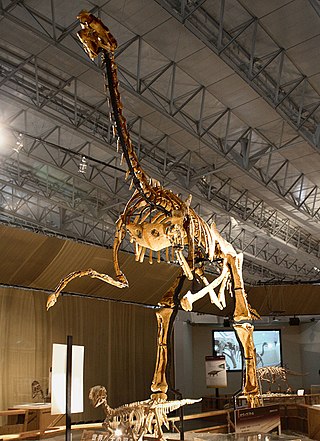
Gigantoraptor is a genus of large oviraptorosaur dinosaur that lived in Asia during the Late Cretaceous period. It is known from the Iren Dabasu Formation of Inner Mongolia, where the first remains were found in 2005.
The Bayin-Gobi Formation is a geological formation in Inner Mongolia, north China, whose strata date back to Albian of the Early Cretaceous period. Dinosaur remains are among the fossils that have been recovered from the formation.

The Bayan Mandahu Formation is a geological unit of "redbeds" located near the village of Bayan Mandahu in Inner Mongolia and China and dates from the late Cretaceous Period. Laid down in the Campanian, it is dated somewhat uncertainly to between 75 and 71 mya.

Tsagandelta is a genus of deltatheroidean therian mammal that lived in Asia during the Late Cretaceous. Distantly related to modern marsupials, it is part of Deltatheroida, a lineage of carnivorous metatherians common in the Cretaceous of Asia and among the most successful non-theropod carnivores of the region. It represents the first known mammal from the Bayan Shireh Formation.































